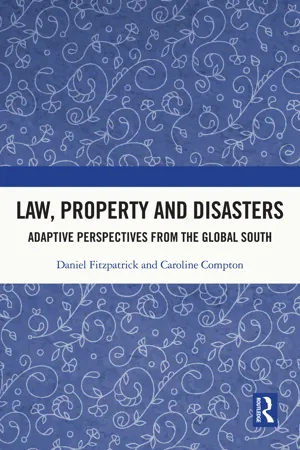
Law, Property and Disasters
Adaptive Perspectives from the Global South
- 185 pages
- English
- ePUB (mobile friendly)
- Available on iOS & Android
Law, Property and Disasters
Adaptive Perspectives from the Global South
About This Book
This book re-considers property law for a future of environmental disruption.
As slogans such as "build the wall" or "stop the boats" affect public policy, there are counter-questions as to whether positivist or statist notions of property are fit for purpose in a time of human mobility and environmental disruption. State-centric property laws construct legal fictions of sovereign control over land, notwithstanding the persistent reality of informal settlements in many parts of the Global South. In a world affected by catastrophic disasters, this book develops a vision of adaptive governance for property in land based on a critical re-assessment of state-centric property law.
This book will appeal to a broad readership with interests in legal theory, property law, adaptive governance, international development, refugee studies, postcolonial studies, and natural disasters.
Frequently asked questions
1 Land law and the state
Introduction
Ontologies of property
Table of contents
- Cover
- Half Title
- Title Page
- Copyright Page
- Dedication
- Contents
- Acknowledgements
- 1 Land law and the state: New contexts of human mobility
- 2 Property and sovereignty: A postcolonial perspective
- 3 Polycentric property systems
- 4 Property law and disaster vulnerability: The case of Typhoon Haiyan
- 5 Land and the lens of the state: Law, rights, and disaster risk reduction
- 6 Land titling after the Indian Ocean tsunami disaster
- 7 Community mapping: Adjusting property after the tsunami
- 8 Toward adaptive property law
- Index